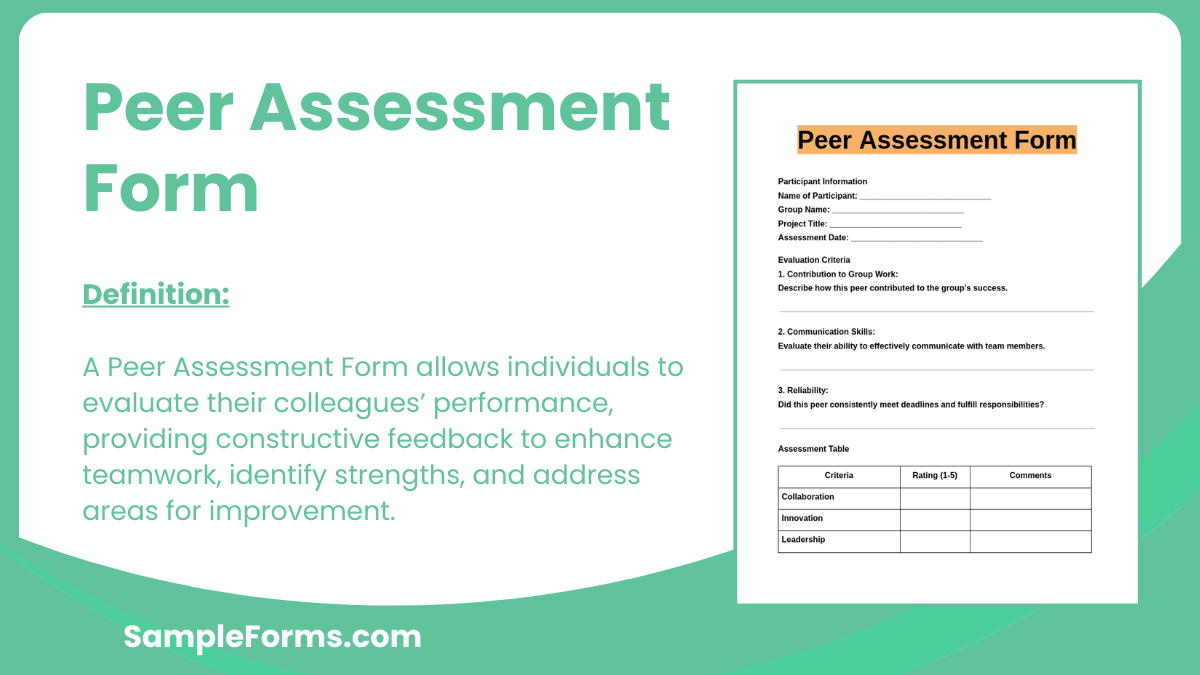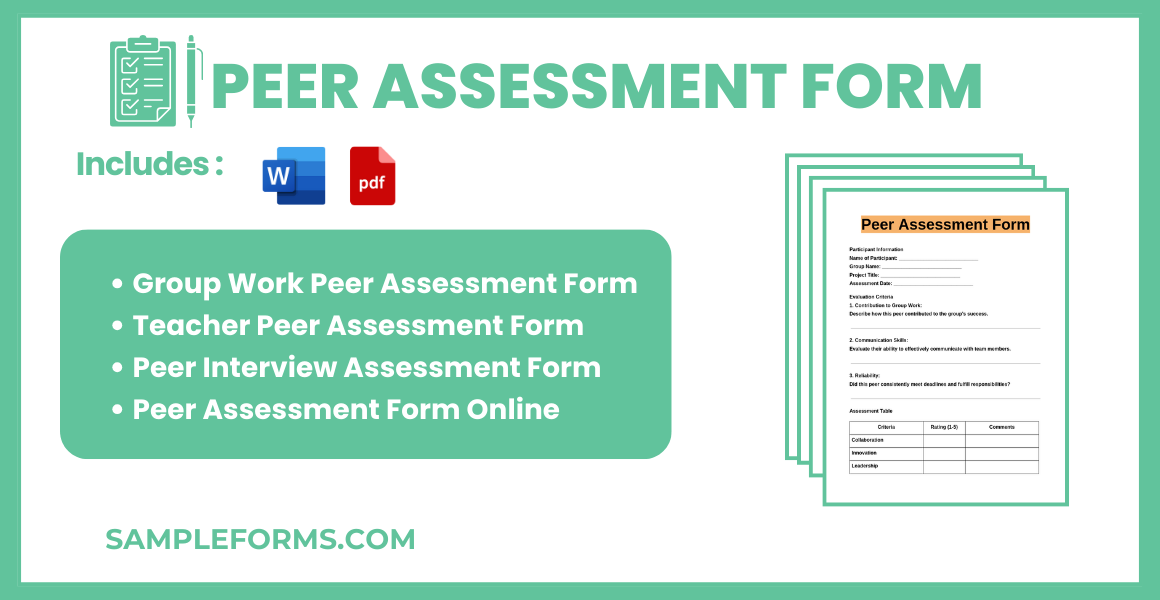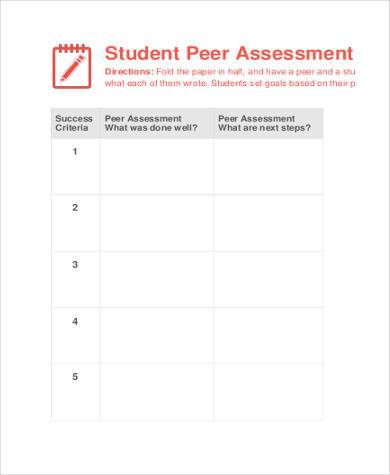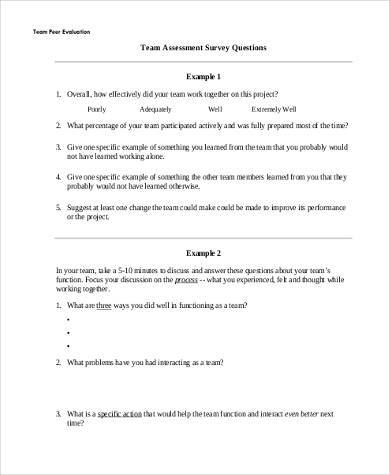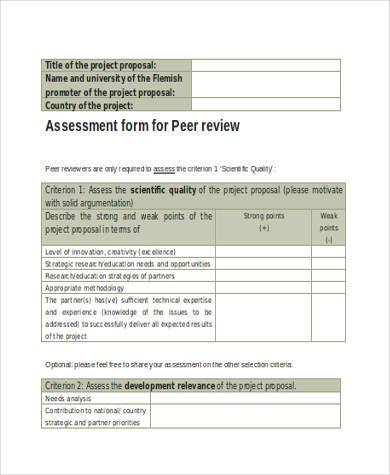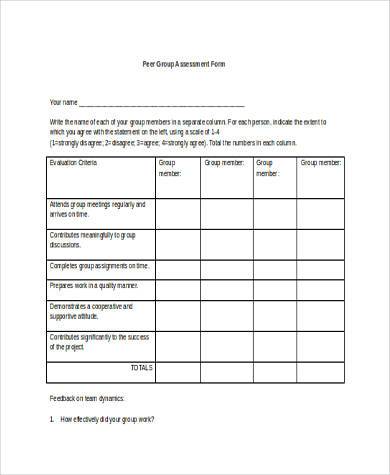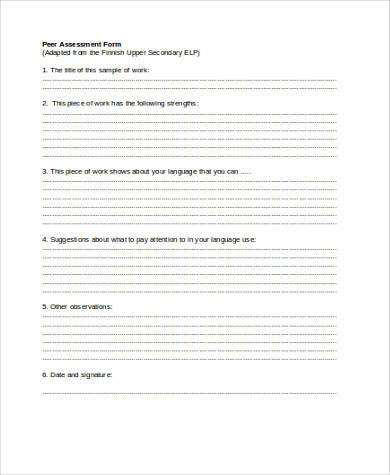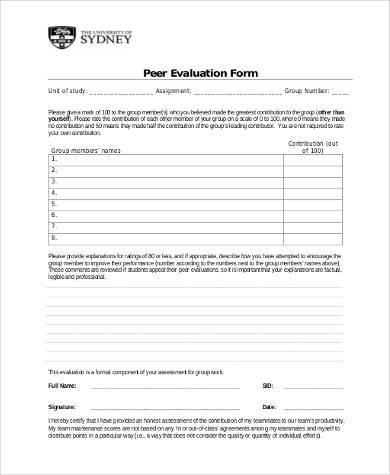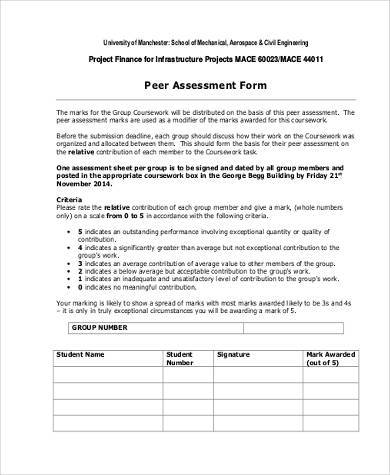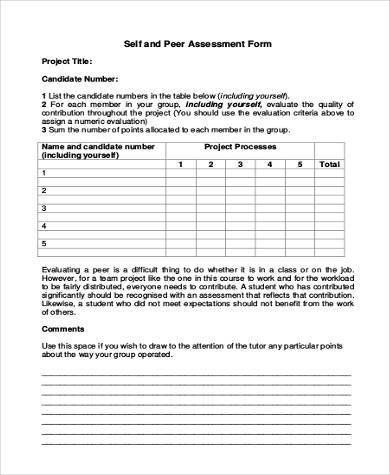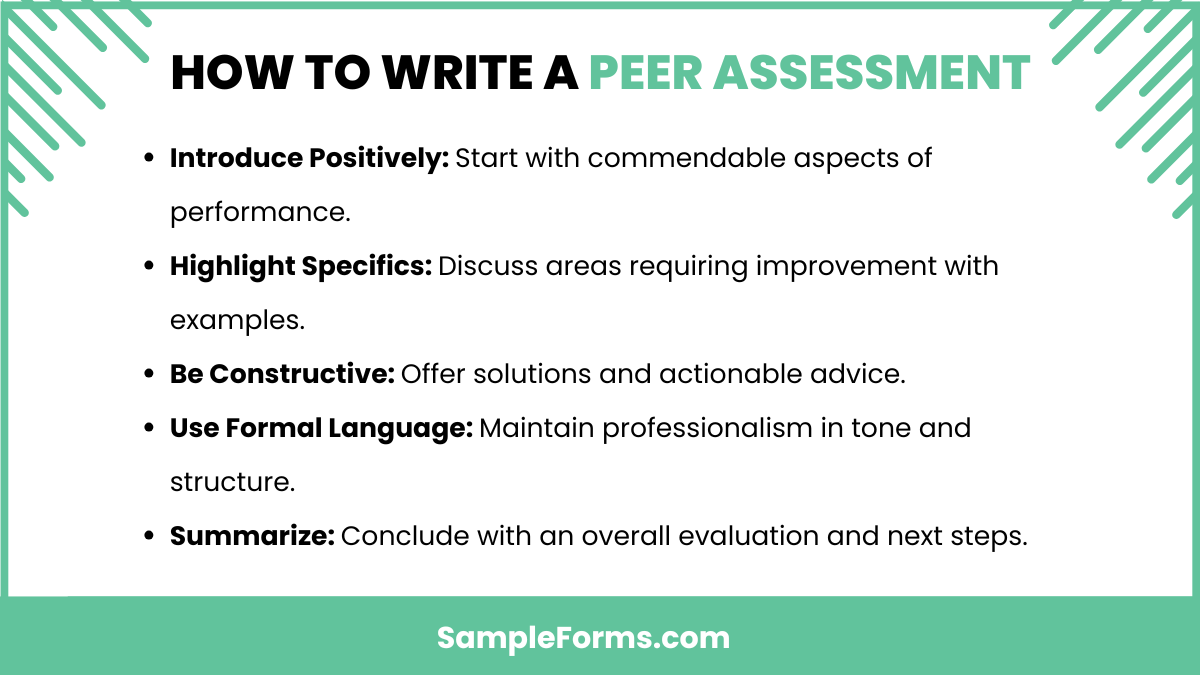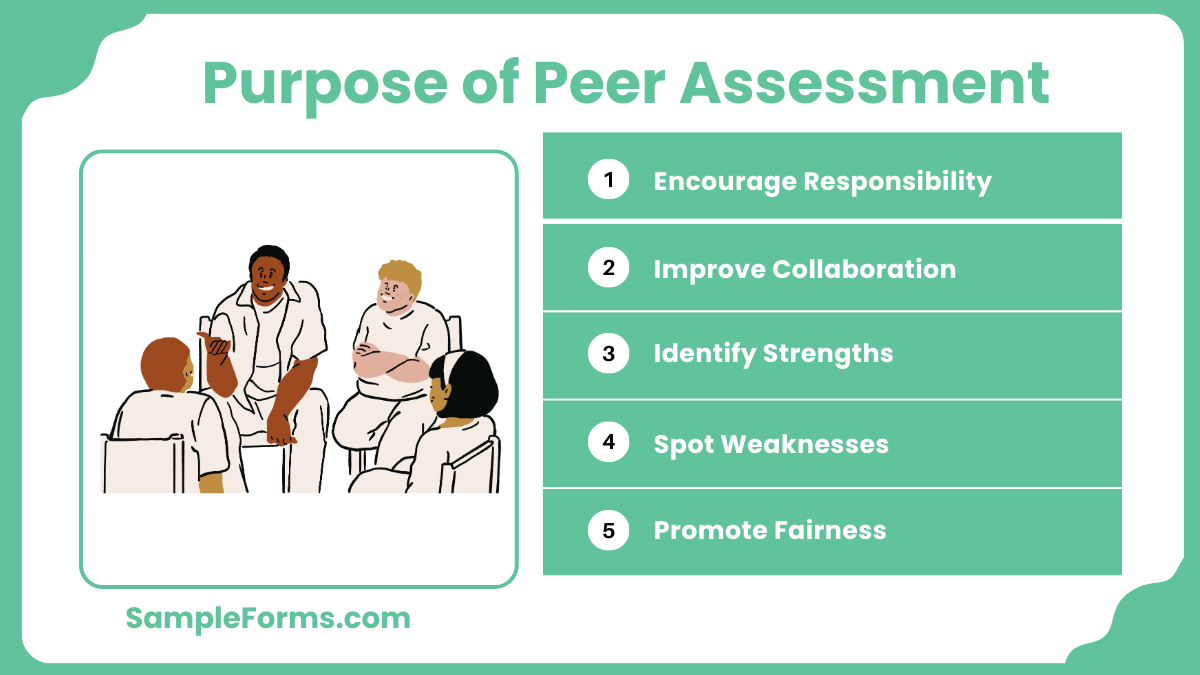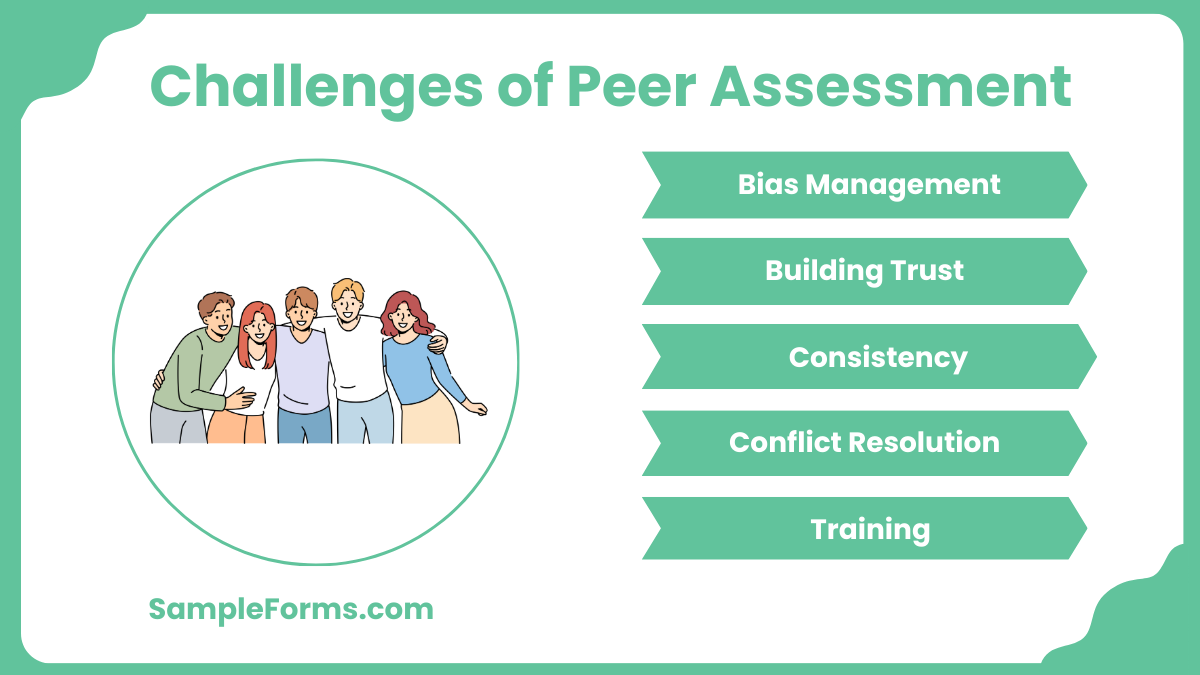A Peer Assessment Form serves as a powerful tool for evaluating the performance, contributions, and teamwork of individuals in a group. Acting as a structured feedback mechanism, it ensures objectivity and provides actionable insights to improve collaboration. With practical examples and templates, this guide highlights how to implement a Assessment Form approach, encouraging constructive critique and fostering accountability. Whether used in educational settings or workplaces, this form promotes transparency and continuous improvement. Dive into this comprehensive guide to explore its importance, structure, and practical applications in both personal and professional growth.
Download Peer Assessment Form Bundle
What is Peer Assessment Form?
A Peer Assessment Form is a structured tool designed for individuals to evaluate the contributions, skills, and performance of their peers within a group setting. This form enhances accountability, promotes constructive feedback, and fosters a sense of shared responsibility. By incorporating specific metrics and open-ended questions, it encourages detailed insights into individual strengths and areas for improvement. The form’s standardized approach ensures fairness and consistency, making it a valuable resource for team dynamics and development.
Peer Assessment Format
Evaluator’s Name: _____________________________
Position: _____________________________
Date: _____________________________
Peer Being Assessed: _____________________________
Position: _____________________________
Criteria:
- Communication Skills:
Evaluate their ability to express ideas and collaborate. - Teamwork:
Assess contributions to group projects and initiatives. - Work Quality:
Comment on accuracy, efficiency, and creativity in tasks. - Leadership (if applicable):
Describe leadership skills demonstrated during teamwork.
Strengths:
- Highlight positive attributes observed in your peer’s performance.
Suggestions for Improvement: _____________________________
Additional Comments: _____________________________
Evaluator’s Signature: _____________________________
Date: _____________________________
Group Work Peer Assessment Form
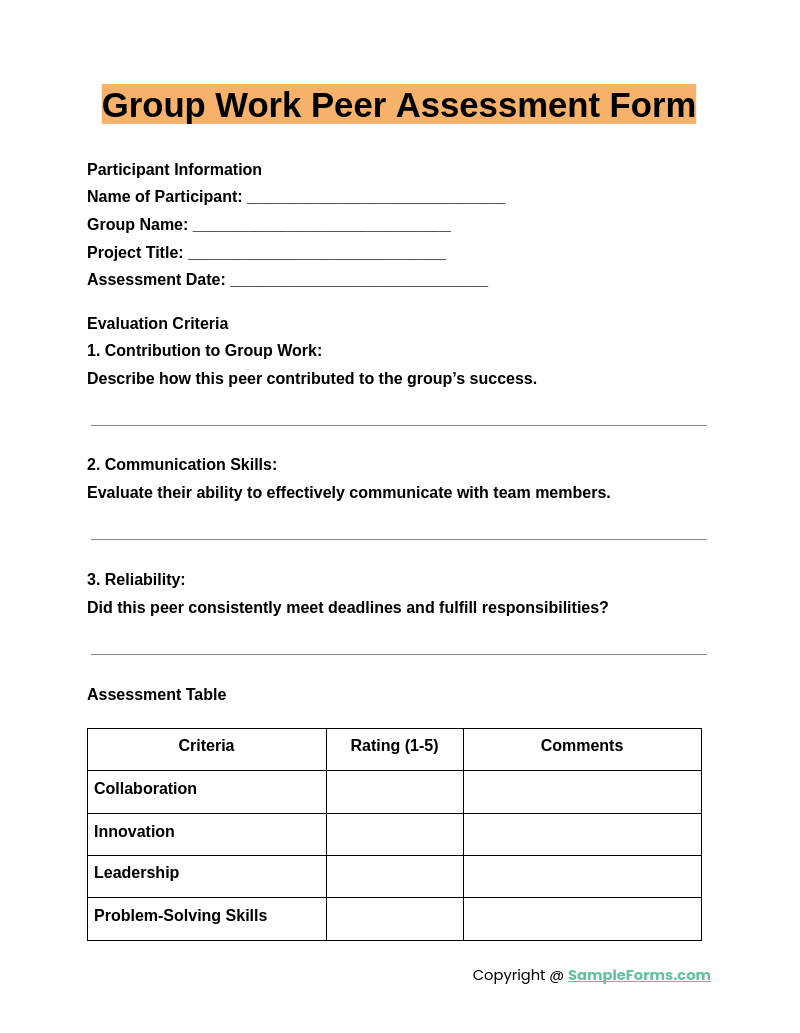
A Group Work Peer Assessment Form evaluates individual contributions in team projects. Similar to a Risk Assessment Form, it ensures accountability, measures teamwork effectiveness, and identifies areas for improvement in collaborative tasks.
Teacher Peer Assessment Form

A Teacher Peer Assessment Form is used to evaluate teaching methods and strategies among educators. Like an Interview Assessment Form, it promotes professional development by gathering constructive feedback from colleagues.
Peer Interview Assessment Form
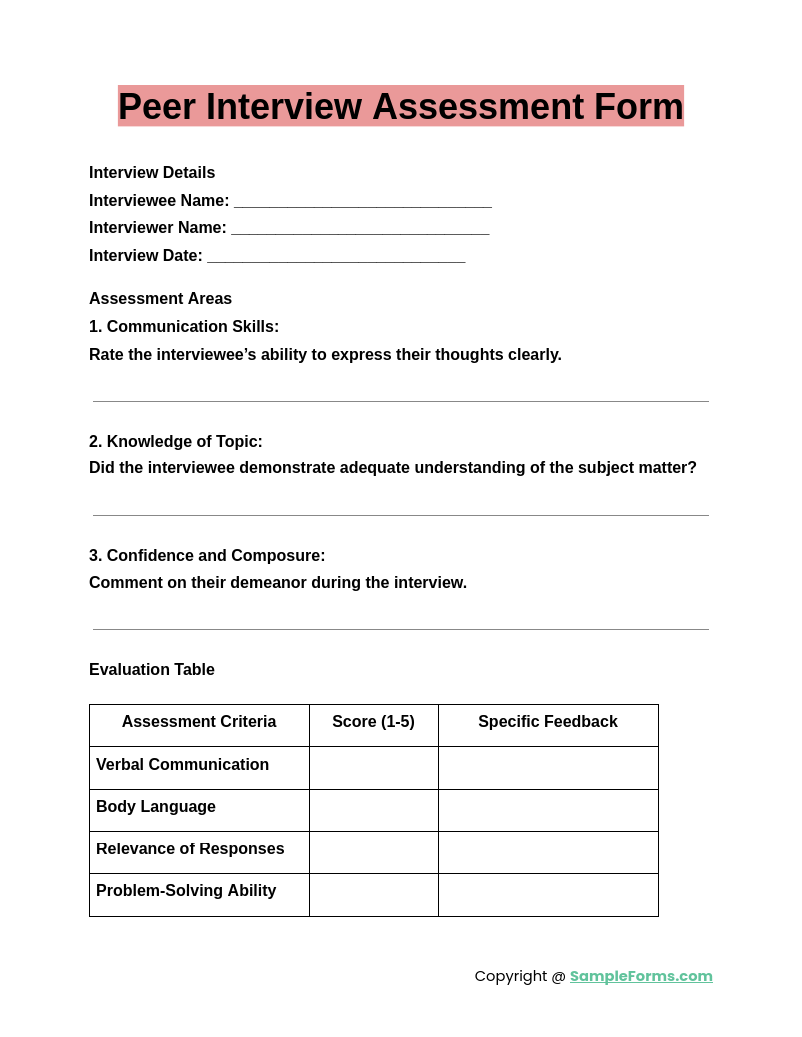
The Peer Interview Assessment Form helps assess candidates’ skills during collaborative interviews. Comparable to a Physical Therapy Assessment Form, it provides structured criteria for unbiased and detailed evaluations.
Peer Assessment Form Online
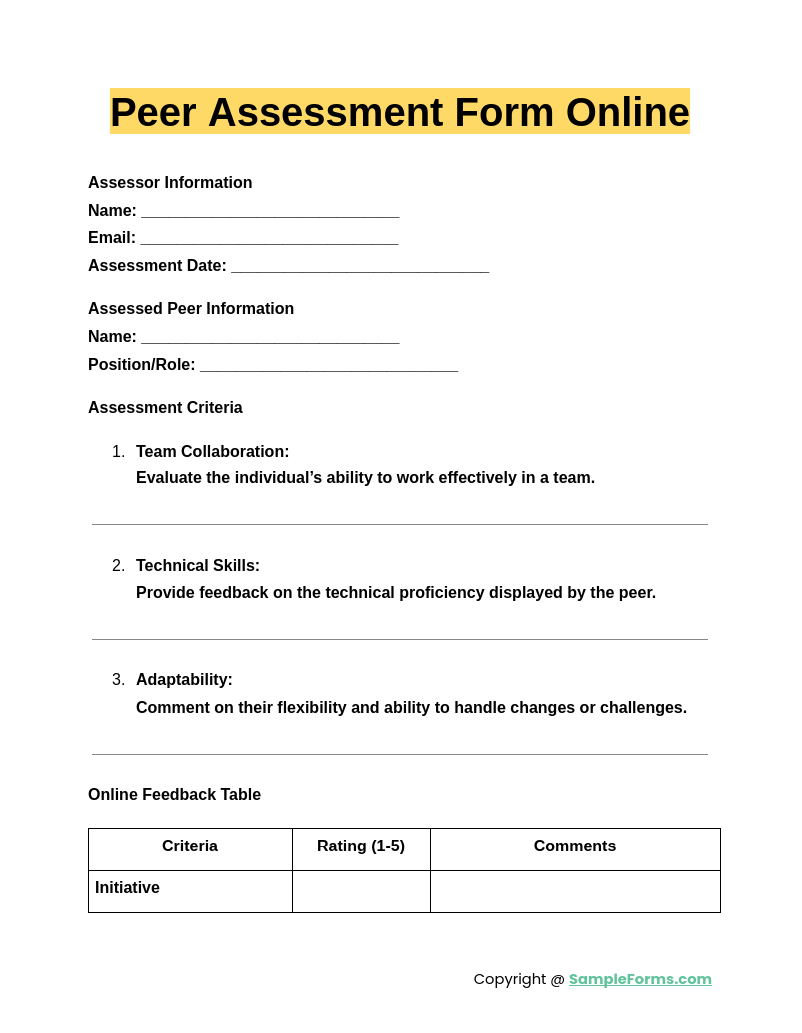
A Peer Assessment Form Online simplifies feedback collection via digital platforms. Much like a Nursing Assessment Form, it ensures accurate evaluations while being accessible and user-friendly for participants.
Browse More Peer Assessment Forms
Student Peer Assessment Form
Team Peer Assessment Form
Peer Review Assessment Form
Peer Group Assessment Form
Peer Assessment Form Example
Peer Evaluation Assessment Form
Peer Teaching Assessment Form
Peer Assessment Form in PDF
Peer and Self Assessment Form
How to fill out an assessment form?
Filling out an assessment form involves careful consideration of criteria, honest responses, and detailed observations, similar to a Fitness Assessment Form for accuracy.
- Understand the Criteria: Familiarize yourself with the form’s purpose and evaluation metrics.
- Be Objective: Provide honest and unbiased responses based on observed performance.
- Provide Details: Elaborate on strengths and weaknesses with specific examples.
- Follow Instructions: Ensure all required sections are completed accurately.
- Review: Double-check entries for clarity and accuracy before submission.
How to write a peer assessment?
Writing a peer assessment requires structured feedback, constructive criticism, and actionable suggestions, akin to compiling a Nutrition Assessment Form for clarity.
- Introduce Positively: Start with commendable aspects of performance.
- Highlight Specifics: Discuss areas requiring improvement with examples.
- Be Constructive: Offer solutions and actionable advice.
- Use Formal Language: Maintain professionalism in tone and structure.
- Summarize: Conclude with an overall evaluation and next steps.
What is the purpose of peer assessment?
Peer assessment promotes accountability, improves collaboration, and identifies strengths and weaknesses, much like a Psychosocial Assessment Form aids in understanding behavioral patterns.
- Encourage Responsibility: Foster a sense of accountability among participants.
- Improve Collaboration: Strengthen teamwork by addressing group dynamics.
- Identify Strengths: Highlight areas where individuals excel.
- Spot Weaknesses: Pinpoint areas needing improvement for growth.
- Promote Fairness: Ensure contributions are recognized and valued equally.
What are the disadvantages of peer assessment?
Peer assessment can involve biases, inconsistencies, and time consumption, similar to challenges encountered in completing a Mental Health Assessment Form.
- Subjectivity: Responses may be influenced by personal biases.
- Inconsistencies: Variability in evaluation standards among peers.
- Time Intensive: Requires significant time for thorough evaluations.
- Potential Conflicts: Risk of disputes arising from negative feedback.
- Lack of Expertise: Peers may lack the skill to assess objectively.
What are the challenges of peer assessment?
Peer assessment challenges include maintaining fairness, objectivity, and trust, akin to the complexities of a Functional Behavior Assessment Form.
- Bias Management: Overcome favoritism or prejudices.
- Building Trust: Ensure transparency to maintain credibility.
- Consistency: Standardize evaluation criteria for uniformity.
- Conflict Resolution: Address disagreements effectively.
- Training: Equip peers with assessment skills for accuracy.
What is a common assessment form?
A Health Assessment Form provides a standardized tool for evaluating various aspects of an individual’s physical and mental well-being in a structured manner.
What is an example of a peer assessment?
Evaluating a colleague’s teamwork using a Skills Assessment Form is an example of peer assessment that highlights contributions and areas for improvement.
What is a peer assessment score?
A Teacher Assessment Form may include a peer assessment score reflecting individual performance based on predefined criteria and peer evaluations.
What is a short note on Peer evaluation?
Peer evaluation, like a Preschool Assessment Form, encourages collaborative feedback, promoting learning and development while addressing areas needing improvement.
Is peer assessment good or bad?
Peer assessment is effective if conducted transparently, much like a Patient Assessment Form, but biases can impact its reliability without proper guidelines.
What does peer assessment score mean?
A peer assessment score, such as in a Needs Assessment Form, quantifies individual contributions and performance based on peer feedback and evaluation.
How do you write an assessment of someone?
Write objectively, using criteria like a Restaurant Risk Assessment Form, to detail strengths, areas for improvement, and actionable suggestions.
How long should a peer review be?
Peer reviews, similar to a Medical Assessment Form, should be concise but detailed enough to provide meaningful insights, typically within one to two pages.
What is a basic assessment report?
A basic assessment report, like a Self Assessment Form, includes evaluations of performance, goals, and feedback to guide future improvements effectively.
Is peer assessment good or bad?
Peer assessment, as seen in an Initial Assessment Form, is beneficial for constructive feedback but requires guidelines to prevent biases or conflicts.
The Peer Assessment Form is indispensable for fostering constructive feedback and collaboration. It helps identify strengths, address challenges, and improve overall performance in any group setting. By leveraging tools like the Health Risk Assessment Form, organizations and institutions can promote fairness and accountability, ensuring each member’s contributions are recognized. Use this guide to explore templates and tips that simplify the process while achieving meaningful results in evaluations and teamwork improvement.
Related Posts
-
5 Assessment Methods That Promote Content Retention
-
Enquiry Form
-
FREE 5+ Recruiter Performance Review Forms in PDF | MS Word
-
Job Safety Observation Form
-
FREE 4+ Hazard Observation Forms in PDF
-
FREE 5+ Coach Observation Forms in PDF | MS Word
-
FREE 4+ Child Care Observation Forms in MS Word | PDF
-
FREE 4+ Child Observation Forms in PDF | MS Word
-
Preschool Observation Form
-
Student Observation Form
-
Lesson Observation Form
-
Content Retention Through Assessment Form [ How to, Importance, Tips ]
-
Assessment Form
-
The Importance of Risk Assessment and Safety Statement [ What Is, How to Conduct ]
-
Risk Assessments And Safety Statements Guidelines [ What Is, Process ]
